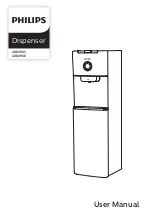
8
Trouble Shooting
System has offensive odor:
Check that no harmful chemicals have been permitted to enter the system.
Check for aerator operation including a restricted filter (
see system not aerating
.) Check against free-
flowing air movement between the digester and the anaerobic pretreatment tank (should be somewhat
airtight between these chambers). Check to see if the system has been pumped recently or large surges
have entered the system, allowing high concentrations of anaerobic waste into digester.
Aerator is not running:
Check circuit breakers for failure. Plug into receptacle or extension cord known
to be working. Check for proper wiring connections by removing four screws at base of blower and
checking connections where the power supply connects to the motor (connectors are within small black
sleeve). Check small overload shear pin for failure (see blower manual or HiBlow website for
instructions). If the prior remedies are not sufficient, replacement might be necessary. Electrical failure
typically will not be remedied by rebuilding the blower pump.
Trouble Shooting Continued…
System is not aerating:
Check aerator for operation. Check aerator filter element for restrictions.
Visually check airline and diffusers for broken connections or restrictions. Check aerator pressure
output using a standard low pressure gauge and compare to manufacturer’s specifications. If aerator is
underperforming, it likely needs to be rebuilt or replaced.
Audible/visual alarm sounds:
Verify that the aerator is working. Check for dislocated airlines. Check
water level, making sure tank is full of water to create backpressure. Check for water in blower. Check
for water in alarm tubing, and blow out if necessary.
Aerator is loud:
Linear compressors are made to function quietly. If the following remedies do not
correct the problem the aerator may need to be rebuilt or replaced. Check for vibrations against solid
structures. Check filter cover for proper torque.
Maintenance Requirements
Ongoing maintenance contracts are required for advanced treatment. The installer of an OSSDS shall
either include the first two years of maintenance with the price of the installation, or as an alternative,
arrange for the maintenance to be provided by an approved 3
rd
party maintenance provider. This must be
spelled out on installation contract. Maintenance provider shall keep records of, and submit maintenance
reports to the permitting authority and the owner of the system. After the first two years, the system
shall be maintained at an annual interval.
Maintenance Duties:
1. Remove filter element from aerator and clean with soapy water. Dry and replace.
2. Test high water alarm and low air alarm for visual or audible warning function.
3. Check components for buildup such as ant beds or grass. Keep all vents clear of foreign materials.
4. Perform sludge measurement in trash tank. Arrange for pumping if within 12 inches of outlet (more
than 24” total sludge depth).
5. Observe performance of digester, check for consistent, even rolling pattern of wastewater.
6. Perform settled solids check from digester. Have tank pumped if settled solids reach 40%.
7. Perform visual check of discharging effluent for clarity, and check for rotten egg odor, which would
signify improper treatment of wastewater.
8. If system is equipped with UV light, check and replace bulb if required.
9. Test operation of sludge return by temporarily switching blower to “manual” on the unmarked switch
inside the cover. Stand back from the return inlet to the trash tank, as there can be a small splash upon
startup of the recirculation. Check for consistent flow intermixed with bursts of air. Be sure to switch it
back to “auto” when done, and observe the digester diffusers resume their airflow.
10. Inspect remainder of disposal system per county requirements, including but not limited to:
Test pump discharge rate, test alarm, inspect disposal field, flush lines if necessary, etc...
Summary of Contents for BNR 500 GPD
Page 5: ...5...






























